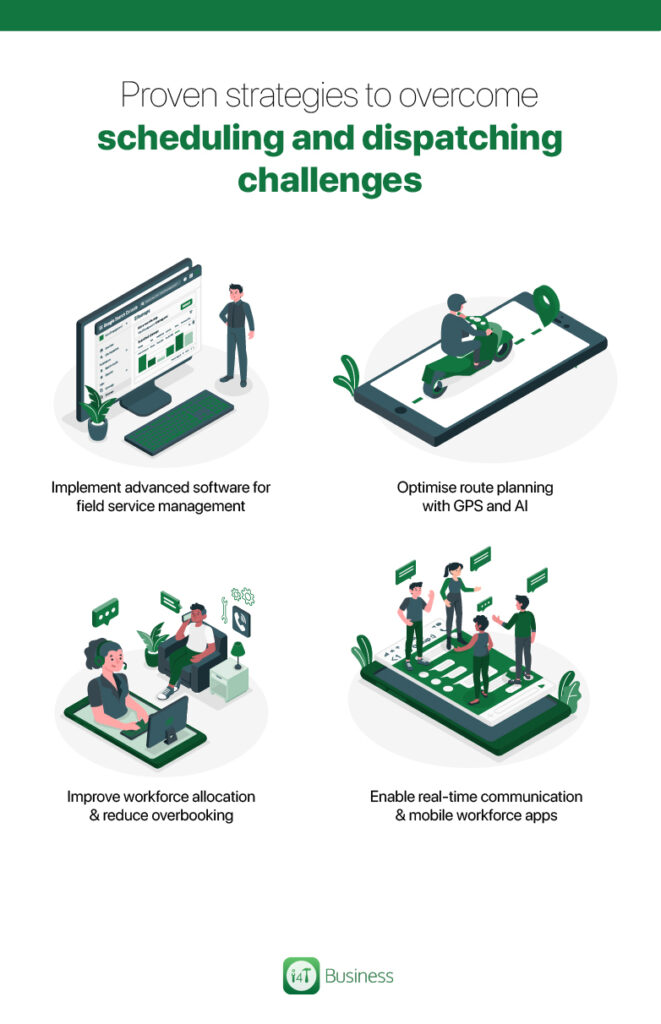Running your field service operations smoothly is not an easy task. You have to deal with last-minute changes to the schedule and unexpected delays, manage technicians, dispatch them to each job efficiently, and much more.
But here’s the thing, job scheduling conflicts and miscommunications are highly common in field service businesses. Without having the right system in place, these shortcomings can cost you time and money and affect your customers’ satisfaction.
That’s where software for field service management comes in. It helps businesses to stay organised, assign jobs faster, and ensure every technician is attending to the right job at the right time.
In this post, we’ll explore some common scheduling challenges and show you better strategies that you can use to overcome them easily. Let’s dive in!
Common challenges in field service scheduling and dispatching
Running your field service business smoothly is tough already. You will face various challenges that will throw your business away from the true goals that you want to achieve.
Let’s look at some of these challenges, so that you can stay clear of them.
Last-minute cancellations and rescheduling
No matter how well you plan, customers may change their minds. They might forget about an appointment, find another provider, or just decide they don’t need the service anymore.
Then there are urgent requests like someone’s AC breaking down in the middle of a heatwave or a business needing emergency repair. Here’s how these situations can affect your operations.
- Cancellations like this will throw off your entire schedule. You’ve already assigned a technician, and now they have an empty slot. That’s lost time and lost revenue.
- Rescheduling isn’t always simple. Finding a new time that works for both the customer and your team can be tricky, especially if your calendar is packed.
- Emergency jobs force quick changes. If a high-priority request comes in, you may have to shuffle things around, delay other jobs, or even ask a technician to work overtime.
- Technicians need real-time updates. If they’re not informed quickly, they might show up at a cancelled job or miss an urgent one.
Inefficient route planning and travel delays
Your technicians might be highly skilled, but if they’re stuck in traffic or taking a longer route than necessary, then your business is wasting time and money.
Let’s take a closer look at how inefficient routing affects field service businesses and why it’s crucial to fix it.
- If your team isn’t taking the most efficient routes, you’re burning extra fuel and limiting the number of jobs they can complete in a day. It can cause various problems that can affect your business.
- The more time technicians spend driving, the fewer service calls they can complete, which directly impacts revenue.
- Fuel costs add up fast. Inefficient routes lead to unnecessary driving, increasing fuel expenses that eat into your profits.
- Vehicles wear out faster. More driving means more maintenance costs and a higher chance of breakdowns, which can lead to service delays.
Even with a solid route in place, real-life situations can throw your schedule off. So, you have to watch out for the following scenarios.
- Heavy traffic leads to delays. Rush hour, road work, or an accident can suddenly turn a 15-minute drive into a 45-minute one.
- Road closures force detours, where your technicians have to take a longer, unplanned route, making them late for appointments.
- Late arrivals frustrate customers. Nobody likes waiting around, and repeated delays can hurt your reputation and lead to bad reviews.
Overbooking or underutilisation of technicians
When managing the schedules of technicians, you have to do more than just fill up their schedules. You have to find the right balance so that every technician will have a workload that they can manage.
- Work doesn’t always flow evenly. Some days, your team is packed with back-to-back jobs, while other times, technicians sit around waiting for assignments. Here’s why an unbalanced workload is a problem:
- Overloaded technicians will struggle to keep up. Rushing through jobs increases mistakes, lowers service quality, and leads to unhappy customers.
- If your team is idling without work, you’re paying wages to them without maximising the output, which hurts profitability.
- Last-minute schedule changes make it worse. When cancellations happen, some technicians may suddenly have open slots while others remain fully booked.
On the other hand, nothing drains motivation faster than an unfair workload. If one technician is constantly overloaded while another barely gets any assignments, frustration starts to build.
- Overworked employees burn out quickly. If they’re always on the go with no breaks, their performance suffers, and they’re more likely to quit.
- Underworked employees feel undervalued. If they’re getting fewer jobs, they may wonder if their skills are being overlooked or if they’re at risk of losing their position.
- Uneven job assignments create tension. Suppose some team members feel they’re working harder than others. In that case, their morale will drop, leading to a less productive work environment.
Communication gaps between dispatchers and technicians
When running a field service business, you have to make sure that dispatchers and technicians stay connected to each other. If there’s miscommunication, it can lead to various problems that affect your entire operations.
Imagine sending a technician to a job, but you have no idea where they are or if they’re running late. Meanwhile, the customer is waiting, getting frustrated, and calling for updates that you don’t have. Without real-time tracking, you would have to deal with various problems.
- If a technician is stuck in traffic or needs extra time on a job, the dispatcher won’t know until it’s too late.
- If you can’t update customers on when to expect their technician, they might cancel or leave bad reviews.
- Technicians waste time on calls. Without automated updates, they have to call in constantly for job details, slowing them down.
On the other hand, communication gaps can lead to situations where a technician shows up at the wrong address or without the right tools.
- If a technician is sent to the wrong place, they have to backtrack, causing delays and upsetting customers.
- A technician might arrive without knowing the issue, so they may not have the right tools or parts.
- Special requirements get overlooked. If a customer needs something specific, like a certain type of repair, and it’s not passed along, the job will get delayed.
Managing emergency and high-priority requests
Emergencies are a part of running a field service business. For example, a customer’s heating system might fail in the middle of winter. These high-priority jobs need immediate attention, but handling them alongside your scheduled appointments can be tricky.
- Not every job can be delayed, so squeezing in emergency requests without disrupting existing schedules is going to be tough.
- Last-minute jobs can cause delays. If an urgent request isn’t handled properly, it can push back scheduled jobs and create a domino effect of delays.
- Some customers might be left waiting. While one customer gets priority service, another might have to wait longer than expected, which can lead to frustration.
- Technicians get overworked. Rushing between emergency calls and regular jobs can burn them out and lead to mistakes.
On the other hand, not every technician is trained for every job. Suppose you come across a high-priority request that requires specialised skills. In that case, sending a technician without the right skills can lead to various issues.
- Limited availability of skilled technicians. If your top experts are already booked, it’s hard to assign specialised jobs quickly.
- Delays due to reassignment. Suppose a technician arrives and realises they don’t have the skills or tools needed. In that case, you’ll have to send another team member, delaying service.
- Frustrated customers. If a job isn’t completed on the first visit, customers will be unhappy, and it might impact your reputation.
Lack of integration with inventory and CRM systems
A well-prepared technician is a productive technician.
Technicians can’t do their jobs efficiently if they arrive at a job site without the necessary equipment. If you don’t track your inventory, you will have to face various issues, such as:
- If a technician gets to a job and realises they don’t have what they need, they have to go back to the warehouse or order parts, delaying the repair.
- Suppose you don’t have the required equipment in hand. In that case, technicians may leave jobs incomplete, requiring a second visit that wastes time and resources.
- Rushed deliveries or multiple trips to a supplier can drive up your operational expenses.
The same goes for customer information; if a technician doesn’t have past service records, they might waste time troubleshooting issues that have already been addressed.
- Suppose a technician doesn’t know what was done on previous visits. In that case, they might spend extra time diagnosing an issue that was already addressed.
- If a technician knows a customer has an older system that frequently needs repairs, they can recommend preventive maintenance or upgrades.
- Customers expect seamless service. If they have to explain their history every time, they will be frustrated and reduce their trust in your business.
Proven strategies to overcome scheduling and dispatching challenges

The efficiency of your scheduling and dispatching function can make or break your field service business.
If your team is always running late, overbooked, or stuck in traffic, you’re losing valuable time, money, and customer trust.
The good news is that you can easily overcome these challenges with the right strategies and tools. Here are six proven strategies that you can use to fix common scheduling and dispatching problems.
1. Implement advanced software for field service management
The days that you had to manage schedules with spreadsheets and phone calls are in the past. There is modern software for field service management that takes the guesswork out of scheduling by automating job assignments and improving overall efficiency.
Here’s how this software can help your business:
- AI-powered software for field service management like i4T Business, automatically assigns jobs based on technician availability, skills, and location.
- Self-service scheduling for customers lets them book and reschedule appointments through a mobile application, reducing inbound calls and last-minute cancellations.
- Automated dispatching ensures the right technician is assigned to the right job at the right time, without overloading your team.
2. Optimise route planning with GPS and AI
If your technicians are taking long and inefficient routes, you’re wasting time and fuel. A smart route planning system ensures they get to job sites quickly and without unnecessary detours.
Here’s how you can optimise the travel routes:
- Real-time GPS tracking helps dispatchers monitor technician locations and re-route them in case of delays.
- AI-driven dynamic re-routing adjusts schedules on the go based on real-time traffic conditions.
- Geofencing and route clustering minimise travel time by grouping jobs in the same area, cutting down on unnecessary travel.
- With better route planning, your team can complete more jobs per day, reduce fuel costs, and improve on-time arrivals.
3. Improve workforce allocation & reduce overbooking
A common problem in field service businesses is uneven workload distribution, where some technicians are overloaded while others don’t have enough work. A better workforce allocation strategy can prevent this.
- Load-balancing strategies distribute jobs evenly among technicians, avoiding burnout and keeping productivity high.
- Historical data and demand forecasting help predict busy periods so you can plan and avoid last-minute scheduling issues.
- Proper shift planning ensures technicians aren’t overworked, improving morale and reducing labour turnover.
4. Enable real-time communication & mobile workforce apps
Miscommunication between dispatchers and technicians can lead to delays, missed important details, and frustrated customers. The solution to this is to use real-time communication tools.
- Equip technicians with mobile applications so that they have instant access to job details, updates, and navigation.
- Use real-time chat and automated notifications to keep dispatchers and field teams in sync.
- Enable customer portals for appointment confirmations, service updates, and feedback, reducing the need for follow-up calls.
5. Develop an emergency response strategy
Emergencies like equipment failures and urgent repairs can happen at any time. Without a proper emergency plan, these situations can disrupt your entire schedule.
Here’s how you can handle emergency requests efficiently:
- Maintain a standby technician pool to handle urgent jobs without pulling resources from scheduled tasks.
- Use priority tagging in your scheduling system so high-urgency jobs get assigned first.
- Leverage AI-powered scheduling software to automatically assign emergency tasks to the nearest available technician.
6. Integrate scheduling with inventory & CRM systems
A smooth operation isn’t just about getting technicians to the job site. You should also make sure that they have the right tools and customer information when they get there.
Here’s how this can help your business and your technicians:
- Real-time inventory tracking prevents technicians from arriving without the necessary tools and equipment, reducing repeat visits.
- Customer history integration ensures technicians have access to past service records. Therefore, they can troubleshoot the problem faster and deliver a better service.
- Automated service reminders keep customers informed about upcoming maintenance, helping you schedule jobs proactively instead of reacting to last-minute requests
Wrapping up
Dealing with scheduling and dispatching challenges doesn’t have to be a constant headache. Use the right strategies and tools to run your field service business smoothly.
The right field service software will ensure the jobs are assigned efficiently, technicians stay productive, and customers receive timely service.
Why struggle with outdated methods when a smarter, automated system can do the heavy lifting for you?
By adopting software for field service management like i4T Business, you can eliminate these scheduling problems easily, boosting overall productivity and keeping the customers happy.
Take the next step today! Explore how i4T Business can transform your scheduling process and help you grow your field service business with ease. Start your free trial.
FAQs
AI helps optimise job assignments, predict delays, and suggest efficient routes, improving overall scheduling accuracy.
Use workforce management software to quickly reassign jobs and notify technicians instantly, ensuring minimal downtime.
Use software for field service management with real-time GPS tracking to provide live updates on technician arrival times.
Use historical data to forecast demand and pre-schedule additional technicians during busy periods.
.
Provide flexible appointment slots, real-time updates, and prompt service to enhance the customer experience.
Hot off the press!

Field Service Management sector operates, the i4TGlobal Team loves to share industry insights to help streamline your business processes and generate new leads. We are driven by innovation and are passionate about delivering solutions that are transparent, compliant, efficient and safe for all stakeholders and across all touch points.










